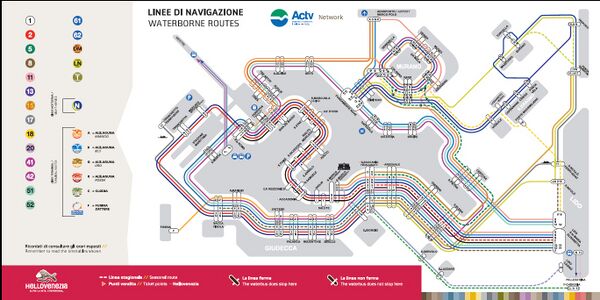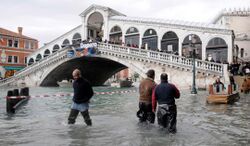Vaporetto
| This page may require cleanup to meet Venipedia's quality standards. Please edit the article and fix the problems. |

Vaporetti, which translates into “steamer,” are the most dominant form of public boat transportation in Venice. These boats can hold up to 220 passengers and their luggage, and their routes wind through Venice’s center and outer circle. Two operators—a captain and a sailor—are needed to run a vaporetto.# These boats are used for the larger, more popular lines of the public transportation system, such as Line 1 and Line 2.
ACTV Lines
The ACTV boat lines are the main form of transportation through Venice other than walking. These lines service historical Venice, the Giudecca, and some of the main islands near historic Venice such as Murano, Burano, and Lido.

The main ACTV lines are 1, 2, 41, 42, 51, 52, and N. Line 1 travels up and down the Grand Canal between Lido Beach and Piaza le Roma. Line 1 takes the shortest path by distance between any 2 stops that are both on the Grand Canal, but it is not necessarily the fastest because of the high frequency with which line 1 boats must stop. A full trip on line 1 from one end of the Grand Canal to the other will take 58 minutes.
Line 2 is one of the more confusing lines to navigate because its path changes depending on the time of year. From September 14th through May 4th, it will make a loop originating at San Zaccaria, traveling clockwise around the western half of Venice and ending at San Marco. Early in the morning and late in the evening, the last stop on the loop will be at Rialto. From May 5th through September 13th, the line 2 vaporetto will make the loop around the western half of Venice and then continue on to Lido Beach. Line 2 was known as line 82 in the not too distant past and is still listed as such in some guidebooks and maps.
Lines 41 and 42 follow the same circular path around the circumference of Venice, but traveling in opposite directions. They also service several stops on Murano and are the most convenient way of traveling to Murano from historical Venice. Line 41 travels counter-clockwise and line 42 travels clockwise. Like lines 41 and 42, lines 51 and 52 follow the same route in opposite directions, traveling around the circumference of Venice. Instead of traveling to Murano, lines 51 and 52 travel to Lido Beach. Line 51 travels counter-clockwise and line 52 travels clockwise. Line N is the only line that is running very late into the night and very early in the morning. Because it is the only such line, it must service all of Venice and a full circuit consequently takes a long period of time.
Alilaguna
The Alilaguna boats travel between Venice and Venice's Marco Polo Airport. These boats are the primary way in which visitors to Venice who arrive by plane reach historic Venice. This option is far more economical than taking a water taxi, and more convenient than taking a bus, as that would leave most visitors rather far away from their final destinations. While the Alilaguna boat trip to or from the airport is rather long, there are some conveniences included that help make the trip better. First, there is luggage storage on the deck of the boat, something which is greatly appreciated by luggage-laden tourists. The staff put down a ramp to help passengers board and take their luggage on the boat for them. In general, traveling to and within Venice with luggage is difficult at best, by the Alilaguna experience has been customized to ease the difficulties as much as possible.
There are four lines: orange, blue, yellow and red. The orange line makes a few stops along the northern section of the Grand Canal and along the northern coast of Venice. The blue line makes stops at Lido Beach and several locations along the north shore of Venice. The yellow line makes stops at San Marco and San Zaccaria. The red line stops at Murano, Lido Beach, and along the southern coast of Venice.
More information about the Alilaguna boats, including a great picture gallery, can be found here.
Effects of Acqua Alta

Aqua Alta is the rising of water levels that occurs during new and full moon phases. Since Venice has such a low altitude, these high tides can severely affect transportation throughout Venice. Special acqua alta tables are placed on many of the pedestrian walkways, but such a simple solution doesn't exist for the vaporetto.
Depending on the severity of the increase in water level, acqua alta can wreak havoc on the vaporetto. All of the main ACTV lines must pass under one or more of the bridges that cross the Grand Canal. Under normal conditions, the boats pass with very little clearance and when acqua alta hits, they will often no be able to take their normal paths. The most common route change is for the boat to turn around and proceed to travel its route in reverse whenever it comes to a bridge which it is unable to pass under. Changes in routes will not be announced prior to boarding the boats but the staff will usually inform passengers of changes while they are on board as the change is being made. The safest options for passengers are to either avoid using the vaporetto during acqua alta or be prepared to disembark early.
Purchasing Tickets

The pricing scheme for vaporetto tickets is fairly complicated, with different prices for residents of Venice, residents of the greater Veneto region, and tourists. There is a further break down in pricing structure for special categories of people, such as students, and tickets lasting for different durations of time. In general, a tourist will pay 6.50 Euro for a one way trip. This is the most expensive way to buy tickets and it will almost always be possible to buy them at a better rate than this. For a full price scheme, see actv.it.
Tickets can be purchased at most of the boat stops or online through veniceconnected.com. If you board a vaporetto without having a ticket, you must request to buy one from staff on board the boat; otherwise you could be subject to a high fine.
References
- Tassinari,Matthew John Student author -- MGE, Setalsingh,Savonne James Student author -- ME, BE, Bourgeois,Amy Laura Liu Student author -- CM, Amilcar,Marcus Calixte Student author -- ECE, Carrera,Fabio Faculty advisor -- ID, & Cocola,James Faculty advisor -- HU. (2011). Mobility in the floating city -- a study of pedestrian transportation. Worcester, MA: Worcester Polytechnic Institute.
- Urban,Jillian O'Toole Student author -- BE, Sweeney,Michael Paul Student author -- BE, Nassima,Igal Student author -- CS, Gardner,Kathleen Anne Student author -- TC, Zeugner,John F.Faculty advisor -- HU, & Carrera,Fabio Faculty advisor -- ID. (2001). Evaluation of tourist use of venetian transportation
See Also
| |||||||||||||||||||||||||||||